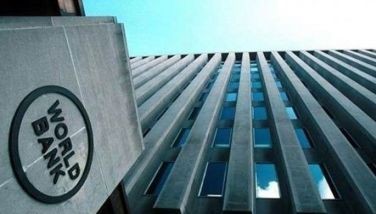CAP to emerge from rehab earlier than projected
January 15, 2007 | 12:00am
Cash-strapped pre-need firm College Assurance Plans (CAP) has expressed confidence it can get out of rehabilitation earlier than the projected eight-year period, according to a company official.
CAP director Robert John Sobrepeña said the company is banking on revenues to be generated from projects it co-owns with property developer Fil-Estate Land Inc. With the continued property boom, CAP expects to get back on its feet in four or five years.
Sobrepeña said these are large-scale projects which include the Tagaytay Twin Lakes, Nasugbu Harbor Town, and the Camp John Hay villas. "These projects will generate revenues for CAP," Sobrepeña said, adding that "with the upswing of the real estate sector, there’s a strong possibility we could get out of rehab earlier than the eight-year forecast."
Sobrepeña said CAP is in the process of liquefying some assets to boost its trust fund and maximize the returns to planholders.
In its rehabilitation program submitted to the court, CAP proposed to build up its capital to P8.36 billion and its trust fund to P14.36 billion. CAP sought a moratorium on its debts in August 2005 after it encountered difficulties in settling its liabilities to about 400,000 planholders.
It blamed its financial difficulties on the deregulation of tuition rates in the early 1990s, effects of the 1997-98 Asian financial crisis on its trust fund investments, implementation of accounting standards patterned after that of the insurance industry, and the refusal of the Securities and Exchange Commission to renew its dealer’s license.
CAP’s license was suspended in 2004 by the SEC after it failed to meet requirements on trust fund and capitalization.
The court approved CAP’s rehabilitation plan late last year subject to certain conditions – stockholders with unpaid subscribed capital stock shall remit their subscription payments no later than March 31, 2007, and the company’s directors, stockholders and officers must dispose and sell all of CAP’s subsidiaries and affiliates no later than Dec. 31, 2008.
The court order also bars shareholders from transferring funds or other assets from one subsidiary or affiliate to another during the rehabilitation period. It also prescribed a schedule of payments to planholders.
In its proposed rehabilitation plan, CAP also sought a 10-year restructuring of its P2.9-billion loan obligations to creditors including Fil-Estate Management Inc., Philippine Veterans Bank, CAP Pension and Pentacapital Investment Corp. The initial payment is expected to commence not earlier than 2008.
As of July 31, 2005, CAP’s trust fund was valued at P6.75 billion, P255 million of which or three percent is liquid.
CAP projects a total trust fund build-up of about P13.56 billion by 2012 with the trust fund achieving a positive balance by 2010. At the end of the implementation of the business plan, CAP expects to have a trust fund balance of about P9.115 billion with about P395 million in liquid assets.
CAP’s projections show that Trust Fund balances after 2012 will be positive and increasing from 2013 to 2025, with an ending positive balance of P20.96 billion with liquid assets of about P11.8 billion as of 2025.
CAP director Robert John Sobrepeña said the company is banking on revenues to be generated from projects it co-owns with property developer Fil-Estate Land Inc. With the continued property boom, CAP expects to get back on its feet in four or five years.
Sobrepeña said these are large-scale projects which include the Tagaytay Twin Lakes, Nasugbu Harbor Town, and the Camp John Hay villas. "These projects will generate revenues for CAP," Sobrepeña said, adding that "with the upswing of the real estate sector, there’s a strong possibility we could get out of rehab earlier than the eight-year forecast."
Sobrepeña said CAP is in the process of liquefying some assets to boost its trust fund and maximize the returns to planholders.
In its rehabilitation program submitted to the court, CAP proposed to build up its capital to P8.36 billion and its trust fund to P14.36 billion. CAP sought a moratorium on its debts in August 2005 after it encountered difficulties in settling its liabilities to about 400,000 planholders.
It blamed its financial difficulties on the deregulation of tuition rates in the early 1990s, effects of the 1997-98 Asian financial crisis on its trust fund investments, implementation of accounting standards patterned after that of the insurance industry, and the refusal of the Securities and Exchange Commission to renew its dealer’s license.
CAP’s license was suspended in 2004 by the SEC after it failed to meet requirements on trust fund and capitalization.
The court approved CAP’s rehabilitation plan late last year subject to certain conditions – stockholders with unpaid subscribed capital stock shall remit their subscription payments no later than March 31, 2007, and the company’s directors, stockholders and officers must dispose and sell all of CAP’s subsidiaries and affiliates no later than Dec. 31, 2008.
The court order also bars shareholders from transferring funds or other assets from one subsidiary or affiliate to another during the rehabilitation period. It also prescribed a schedule of payments to planholders.
In its proposed rehabilitation plan, CAP also sought a 10-year restructuring of its P2.9-billion loan obligations to creditors including Fil-Estate Management Inc., Philippine Veterans Bank, CAP Pension and Pentacapital Investment Corp. The initial payment is expected to commence not earlier than 2008.
As of July 31, 2005, CAP’s trust fund was valued at P6.75 billion, P255 million of which or three percent is liquid.
CAP projects a total trust fund build-up of about P13.56 billion by 2012 with the trust fund achieving a positive balance by 2010. At the end of the implementation of the business plan, CAP expects to have a trust fund balance of about P9.115 billion with about P395 million in liquid assets.
CAP’s projections show that Trust Fund balances after 2012 will be positive and increasing from 2013 to 2025, with an ending positive balance of P20.96 billion with liquid assets of about P11.8 billion as of 2025.
BrandSpace Articles
<
>
- Latest
- Trending
Trending
Latest























